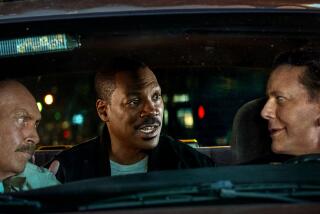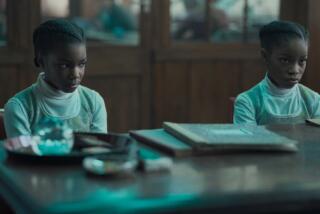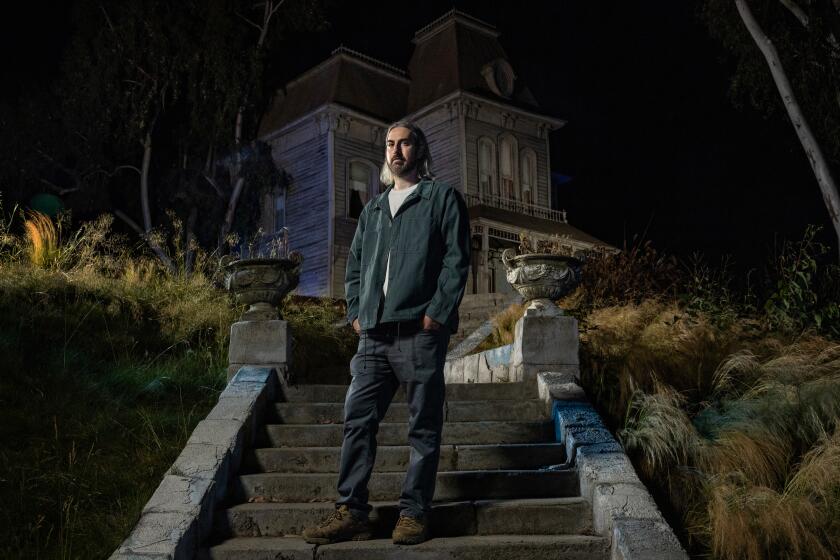Really Big Shoes
British filmmaker Michael Powell has been so associated with one film and one film alone that “Million Dollar Movie,” the second volume of his autobiography, says in impressive letters right on the jacket, “the director of ‘The Red Shoes.’ ”
But Powell did considerably more than the film that launched ballet lessons without number, and he didn’t do that picture alone. The credits read “directed, produced and written by Michael Powell and Emeric Pressburger,” a testament to one of the most remarkable partnerships in film history. These two collaborated on 22 films, mostly in the 1940s and ‘50s under the banner of the Archers, their joint production company with the celebrated logo of an arrow hitting a bull’s-eye.
Though Powell (who was in general responsible for the directing, with Hungarian-born Pressburger doing the writing) worked on films that ran the gamut from “The Thief of Bagdad” to “Peeping Tom” without his partner, the Los Angeles County Museum of Art has sensibly concentrated on the joint ventures in “The Films of Michael Powell and Emeric Pressburger.” This wonderful 12-film series starts Saturday night with a screening of, inevitably, “The Red Shoes,” with Powell’s widow, crack editor Thelma Schoonmaker, in attendance.
Seeing the Powell-Pressburger films today in the excellent prints LACMA has secured is to understand why this partnership is both revered by partisans (who include directors Martin Scorsese and Francis Coppola) and largely unknown to the general public. For these excellent films are both independent and conventional, British and not British, ahead of their time and rooted in it.
More than anything else, the Archers’ films are idiosyncratic, not quite like anyone else’s movies, or even like each other. They’re individualistic, unpredictable entertainments for adults, engaging and sentimental but not at the expense of being smart and literate. Clever, irreverent, laced with unexpected poignancy, they are the clear precursors of today’s independent films, and its probably no coincidence that Pressburger’s grandson ended up producing the groundbreaking British film “Trainspotting.”
Though their exoticism and willingness to deal with sexuality made them not typically British, the Archers films displayed an intense pride in the jaunty, can-do spirit of its British characters. And the Powell-Pressburger films also needled Americans whenever they could, with one character noting waspishly that “the Americans can’t bear anybody to be tougher than themselves.”
And there is, of course, one more thing. The Archers’ films, as befits Powell’s apprenticeship with silent film visual wizard Rex Ingram, were almost all drop-dead gorgeous, pictorial masterpieces with a casual grasp of imagery that still takes the breath away.
The LACMA series offers a special treat when the Archers’ most visually spectacular film, 1947’s “Black Narcissus,” an Oscar winner for both art direction and color cinematography, gets shown on Oct. 11 in a 35-millimeter Technicolor nitrate print from the motion picture academy archives.
Based on a novel by Rumer Godden, “Black Narcissus” details the crises of faith that follow when a group of nuns from the Order of the Servants of Mary open a new school and medical facility in the back of the beyond, 8,000 feet high in a former palace brothel tucked into a corner of the Himalayas.
Sister Clodagh, the youngest sister superior in the order, was played by Deborah Kerr, and her nemesis, Sister Ruth, by Kathleen Byron, leading Powell to tartly note in his autobiography, “so my two mistresses, one ex and one current, were both working for me in the same picture. It was a situation not uncommon in show business, I was told, but it was new to me.”
Also in the picture was hunky David Farrar as the local British agent suspicious of the nuns, Sabu as the extravagant son of the local ruler whose London-bought scent gives the film its name, and the teenage Jean Simmons, miles away from the Ophelia she played almost simultaneously for Laurence Olivier, as the sensuous Ria.
Powell called this “the most erotic film I have ever made,” but what most viewers remember as well is the exquisite, poetic color “Black Narcissus” used, its glorious evocation of the Himalayas made all the more noteworthy because Powell insisted on doing the whole film inside the studio.
As the director pointed out in “A Life in Movies,” the first volume of his autobiography, “The atmosphere in this film is everything, and we must create and control it from the start. Wind, the altitude, the beauty of the setting--it must all be under our control. If we went to India and shot a lot of exteriors, according to the usual plan, and then came back to Pinewood and then tried to match them here, you would have two kinds of colour and two kinds of style.” LACMA’s “Black Narcissus” print includes the flashback sequences, doltishly censored in this country, that show a romance Deborah Kerr’s character had before she took her vows.
Also being shown triumphantly uncut at 2 hours and 43 minutes is the frequently chopped-up 1943 “The Life and Death of Colonel Blimp,” the Archers’ most British and most controversial film.
Colonel Blimp is not the name of a person but rather a type, invented by cartoonist David Low, usually described as an elderly conservative opposed to change on principle and here personified as one Maj. Gen. Clive Wynne-Candy.
Though its local reputation now couldn’t be higher (London-based Time Out says “in the history of British cinema there is nothing to touch it”), Winston Churchill considered the film defeatist and the British government placed obstacles in its way, refusing to allow Laurence Olivier military leave to play the lead. It went instead to Roger Livesey, who gave the performance of his career.
In its leisurely, heartfelt examination of 40 years of Wynne-Candy’s life (with Deborah Kerr playing each of the three women he loved), “Colonel Blimp” is the Archers’ ultimate celebration of British character even though its aim, as Powell wrote, was to be “a hard-hitting film which lampooned the military mind and said we must pull our socks up if we were going to win the war.”
Because even while making its point that the nature of the Nazi menace was such that the British trust in the rules of the game could be fatal, “Colonel Blimp” can’t help creating considerable poignancy about the end of what seemed to be a much more innocent era.
Powell and Pressburger enjoyed using the same actors, and Livesey made a return in 1945’s “I Know Where I’m Going,” one of the screen’s most satisfying romantic concoctions--novelist Nora Sayre has written that she was almost deprived of her allowance when she was 12 because she went to the film week after week. Co-starring with Livesey was another Archers favorite, Wendy Hiller, who was to have had Kerr’s part in “Colonel Blimp” until she became pregnant.
The person who knows where she’s going is exuberant, energetic Joan Webster (Hiller), a most single-minded young woman, introduced, in one of the Archers’ typically inventive credits sequences, as a determined toddler. The film takes her to the Hebrides, the western isles of Scotland, where she is to marry one of the richest men in England.
But bad weather prevents Joan from getting to the island where the ceremony is to be held, and she is forced to spent considerable time with the mysterious Torquil MacNeil, a.k.a. MacNeil of Killoran (Livesey), a handsome gentleman who just happens to be home on a brief leave. Filled with singing, dancing and local color, “I Know Where I’m Going” is romantic in more than its plot; it glories in the fog, wind and waves of a beautifully photographed physical world.
“I Know Where I’m Going” is also noteworthy because Livesey, who was in a hit play on the West End and couldn’t leave London, was able to star in the location-heavy film even though, in Powell’s words, “he never came within five hundred miles of the Western Isles.” Intense work with a double and editing tricks lead to a perfect illusion that justifies the director’s description of the deception as “one of the cleverest things I ever did in movies.”
The Archers dealt with World War II in more than “Colonel Blimp.” “Contraband,” from 1940 and one of the earliest films in the series, is a nifty programmer starring Conrad Veidt and Valerie Hobson in a crackling spy-and-counterspy intrigue set in London during the blackout. “It was all pure corn,” the always clear-eyed Powell wrote, “but corn served up by professionals, and it worked.”
More sophisticated was 1949’s “The Small Back Room,” which featured David Farrar and Kathleen Byron of “Black Narcissus” in a multifaceted character study/thriller about a weapons expert with an artificial leg searching for a reason to live.
Unavailable in this country, “The Small Back Room” is much more real emotionally than films from this era usually are and boasts an unusual mixture of tones, containing both a surrealistic nightmare sequence and a hyper-real 17-minute bomb-dismantling interlude. But, Powell admitted ruefully, “the setting was wartime London and [by 1949] everybody had had enough of that.”
The series’ other films, which include favorites like “Tales of Hoffman” and “A Matter of Life and Death/Stairway to Heaven,” are equally enticing, equally individual, equally bravura. None of them is reducible to an easy summation, hardly any would survive a studio pitch meeting, and that’s why the opportunity to see them on the big screen is so welcome.
*
* L.A. County Museum of Art’s Bing Theater, 5905 Wilshire Blvd. Schedule: Saturday, “The Red Shoes”; Oct. 3, “The Spy in Black,” “Contraband”; Oct. 4, “A Matter of Life and Death / Stairway to Heaven,” “The Small Back Room”; Oct. 10, “I Know Where I’m Going,” “A Canterbury Tale”; Oct. 11, “Black Narcissus,” “Gone to Earth / The Wild Heart”; Oct. 17, “The Life and Death of Colonel Blimp”; Oct. 18, “The Tales of Hoffman,” “Oh . . . Rosalinda!!” Information: (213) 857-6010.
More to Read
Only good movies
Get the Indie Focus newsletter, Mark Olsen's weekly guide to the world of cinema.
You may occasionally receive promotional content from the Los Angeles Times.







